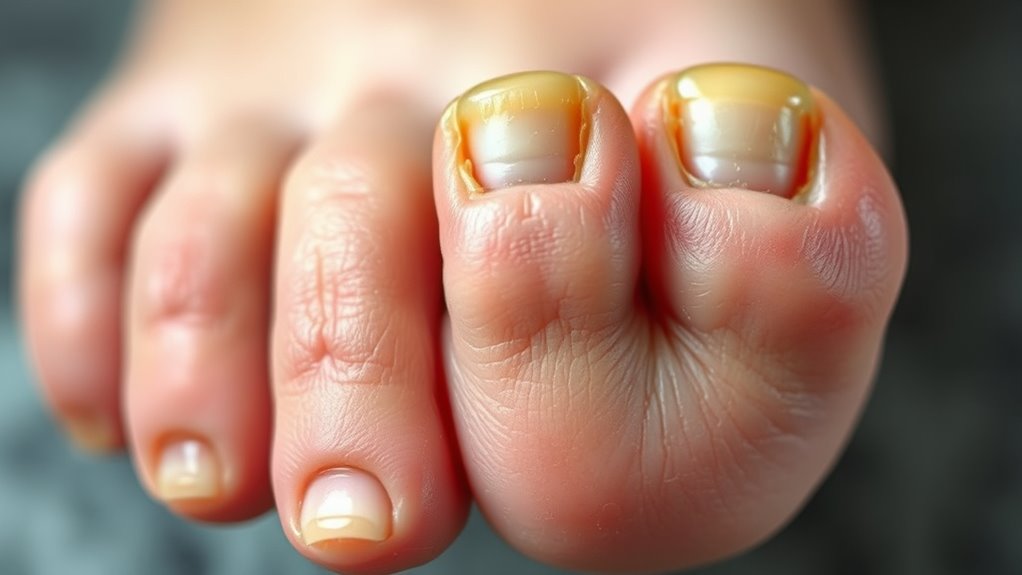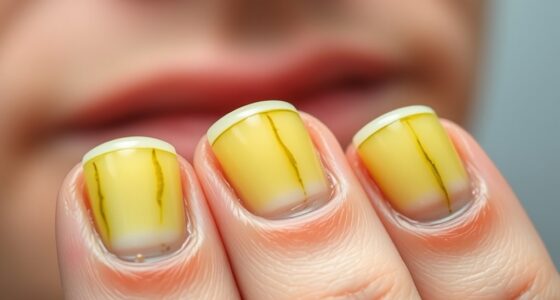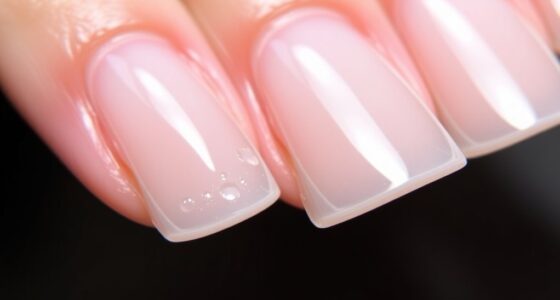If you notice your nails changing color, thickening, or becoming brittle, it’s a warning sign of nail fungus. You might also see debris under the nails, experience pain, or detect a foul odor. Skin around the nails could become red, swollen, or itchy. Acting early by maintaining good hygiene, keeping nails dry, and avoiding shared tools can prevent the infection from worsening. Continue to explore how to spot and respond to these signs effectively.
Key Takeaways
- Look for early signs like yellow or white discoloration and slight nail texture changes.
- Notice if nails become thick, brittle, or deformed, indicating progression.
- Watch for debris buildup, foul odor, or increased nail brittleness.
- Be alert to pain, redness, swelling, or skin changes around the nails.
- Practice good hygiene, keep nails dry, avoid sharing tools, and seek prompt treatment when symptoms appear.
Discoloration of the Nails
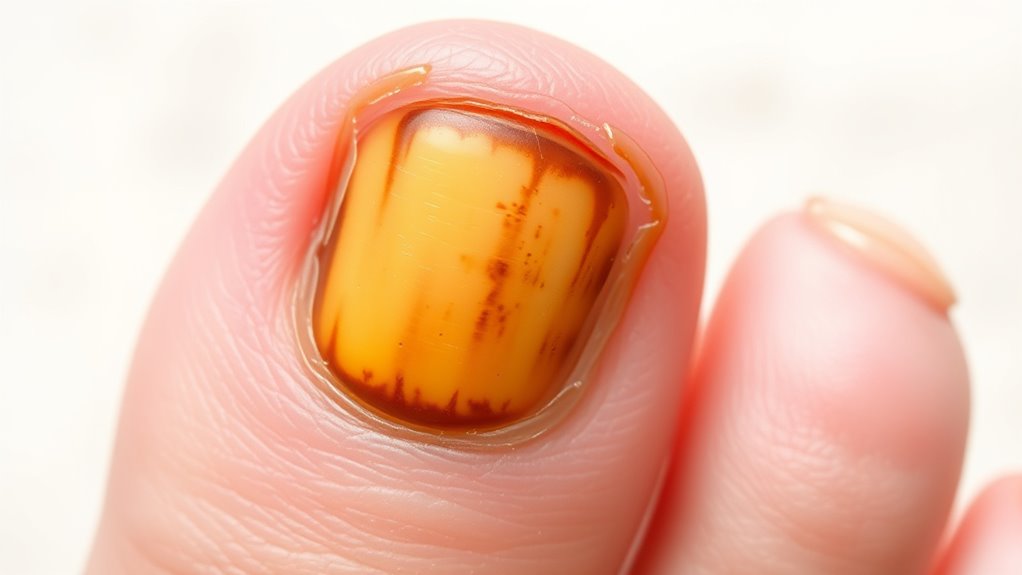
Discoloration of the nails is often one of the earliest and most noticeable signs of toenail fungus. You might see your nail turn yellow, brown, or even white, signaling pigment changes beneath the surface. Nail discoloration occurs because the fungus affects the nail plate, leading to uneven coloration and spots. These pigment changes can start subtly but become more pronounced over time. It’s important to pay attention to any changes in nail color, especially if they persist or worsen. Early detection of nail discoloration can help you take prompt action before the infection spreads or causes further damage. Recognizing these initial signs is vital for effective treatment and avoiding more serious nail problems down the line.
Thickening and Deformation of Nail Plates
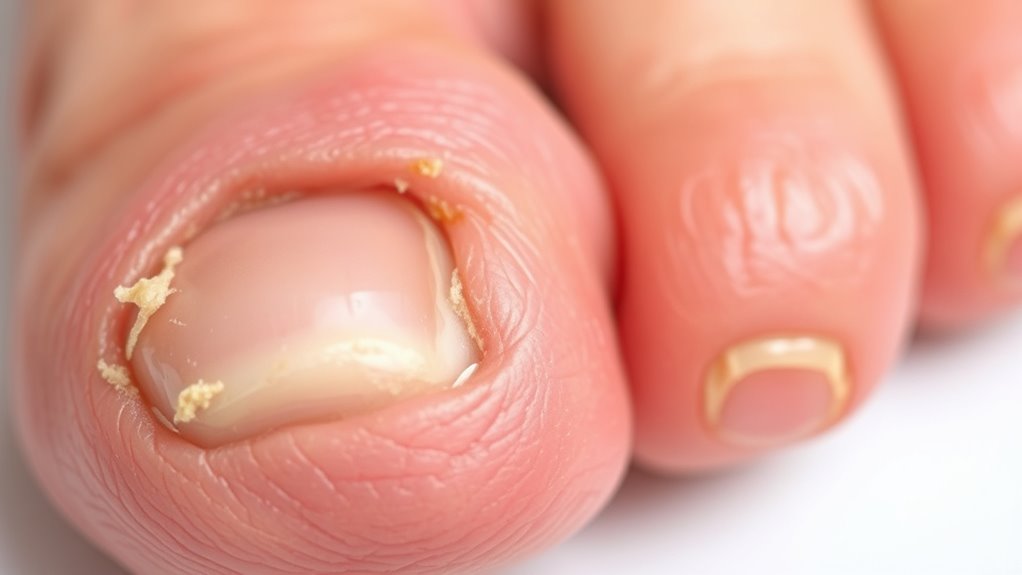
As toenail fungus progresses, it often causes the nail plates to thicken and become deformed. This nail plate thickening results in a noticeable increase in nail size, making it difficult to trim or clean properly. You may observe various nail deformation patterns, such as uneven surfaces, ridges, or distorted shapes that deviate from normal nail anatomy. These changes can lead to discomfort and aesthetic concerns, signaling the need for prompt action. Recognizing these signs early can prevent further deterioration and complications. Be alert for the following indicators:
- Significant increase in nail thickness
- Uneven or irregular nail surface
- Distorted nail shape or structure
- Presence of ridges or bumps
- Nails lifting or separating from the nail bed
Additionally, enhanced blood flow to the affected area can sometimes contribute to inflammation and further nail damage if left untreated.
Crumbling or Brittle Nails
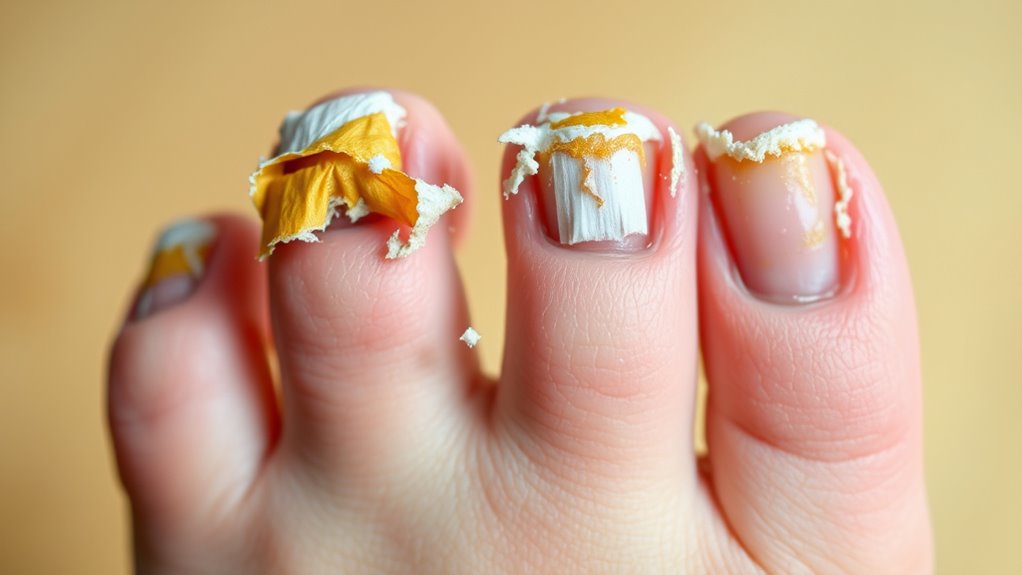
When toenail fungus worsens, it often causes nails to become brittle and prone to crumbling. You might notice your nails breaking easily or flaking apart with minimal pressure. This is a clear sign that the infection has advanced. To address this, explore treatment options like antifungal medications, topical treatments, or laser therapy, which can help restore nail health. Prevention strategies are equally important; keeping your feet dry, wearing breathable shoes, and avoiding walking barefoot in public areas can reduce your risk of worsening the infection. If you notice your nails becoming fragile or crumbling, don’t ignore it—early intervention can prevent further damage and promote healthy nail growth. Consulting a healthcare professional for personalized advice and appropriate treatment is recommended. Additionally, staying informed about best antifungal treatments can improve your chances of successfully combating the infection.
Foul Odor Around the Nails

Ever notice a foul smell around your nails? This could be a sign of infection or fungus. Poor hygiene practices often lead to the buildup of bacteria and fungi, causing unpleasant odors. Proper nail trimming techniques help prevent debris and moisture from accumulating under your nails, reducing infection risk. To address the odor:
- Maintain regular hand and foot hygiene routines
- Keep nails dry and clean, especially after sweating
- Use antiseptic solutions when necessary
- Avoid sharing nail tools to prevent cross-contamination
- Trim nails straight across to prevent trapping dirt and bacteria
Recognizing foul odor early encourages prompt action. Improving hygiene practices and adopting correct trimming techniques can stop fungal growth in its tracks and restore fresh, healthy nails. Regularly inspecting for signs of airborne pollutants can further help prevent infections related to poor indoor air quality.
Changes in Nail Texture and Surface

You might notice your nails becoming thicker or developing an uneven surface. Cracks or ridges can also appear, signaling a change in texture. These signs could be related to a fungal infection, so keep a close eye on your nails. Recognizing early signs can help you seek prompt treatment.
Thickened Nail Surface
A thickened nail surface is a common sign of nail fungus, often indicating the infection’s progression. As the fungus develops, you may notice your nails becoming denser and more elevated, altering their natural appearance. Changes in nail growth patterns can lead to irregular or slowed growth, while nail shape changes may cause the nail to become more curved or swollen. These surface alterations often make the nail feel rough or brittle, reducing its strength. Recognizing these signs early can prompt timely treatment, preventing further damage. Additionally, AI-powered diagnostics are emerging as tools to assist in early detection of nail conditions, including fungal infections.
Cracked or Ridged Nails
Cracked or ridged nails often signal nail fungus affecting the surface texture. When you notice these changes, it’s essential to examine your nail hygiene and grooming habits. Poor nail hygiene can allow fungi to thrive, leading to visible ridges or cracks. Ridged nails may appear as vertical lines running from cuticle to tip, while cracks can develop along the surface, making nails more susceptible to infection. To prevent this, keep your nails clean and dry, and avoid biting or aggressive grooming that damages the surface. Proper nail grooming helps maintain healthy nails and reduces the risk of fungal growth. Additionally, understanding firewood handling techniques can help prevent the spread of fungi and other pathogens. If you observe persistent ridges or cracks, it’s a sign to seek early treatment, as addressing the issue promptly can prevent further infection.
Separation of Nail From Nail Bed
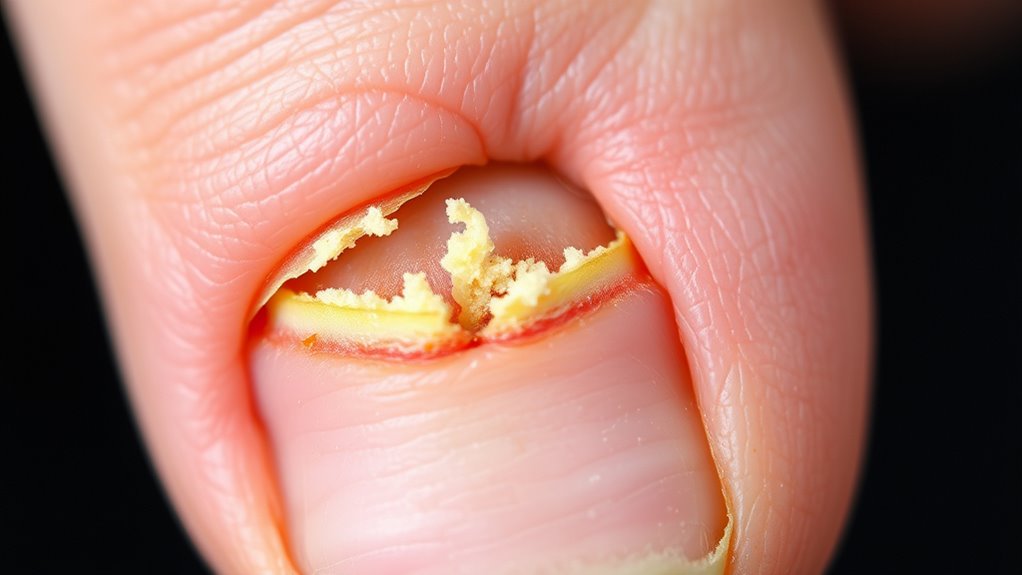
You might notice visible gaps between your nail and nail bed, which can indicate separation. Increased nail mobility is another sign that your nail isn’t firmly attached anymore. These changes often signal an underlying issue, such as a fungal infection, that requires attention. Recognizing pinball machine weight can help you understand the physical characteristics of your nail and its stability.
Visible Nail Gaps
Visible nail gaps occur when the nail begins to separate from the nail bed, creating noticeable spaces. This separation often signals abnormal nail growth and can be an early sign of underlying issues, including hidden fungal signs. If you notice these gaps, it’s essential to monitor for other symptoms and seek prompt action. Such gaps can compromise nail strength and may lead to discomfort or infection. Recognizing these early signs allows you to address toenail health before the problem worsens. Pay close attention to changes in nail texture, color, and thickness alongside these gaps. Addressing nail growth irregularities early can prevent more serious fungal infections and maintain healthy nails.
- Changes in nail color or texture
- Thickening or brittleness
- Discoloration around gaps
- Foul odor
- Pain or tenderness
Increased Nail Mobility
Increased nail mobility occurs when the nail starts to lift away from the nail bed, making it easier to move or separate with gentle pressure. This change indicates a loss of nail flexibility, often caused by fungal infection. As the nail becomes more mobile, it may feel loose or wobbly, and you might notice it shifting when touched. The separation can lead to discomfort or even pain, especially if the nail continues to detach. Recognizing this early sign is essential, as it suggests the fungus is weakening the nail’s attachment. If you observe increased nail mobility, it’s a clear warning sign that fungal activity is progressing. Addressing this promptly can prevent further damage and help you take the necessary steps toward treatment. Additionally, color accuracy in the affected area may diminish, reflecting changes in the nail’s appearance and health.
Excessive Nail Debris Under the Nail
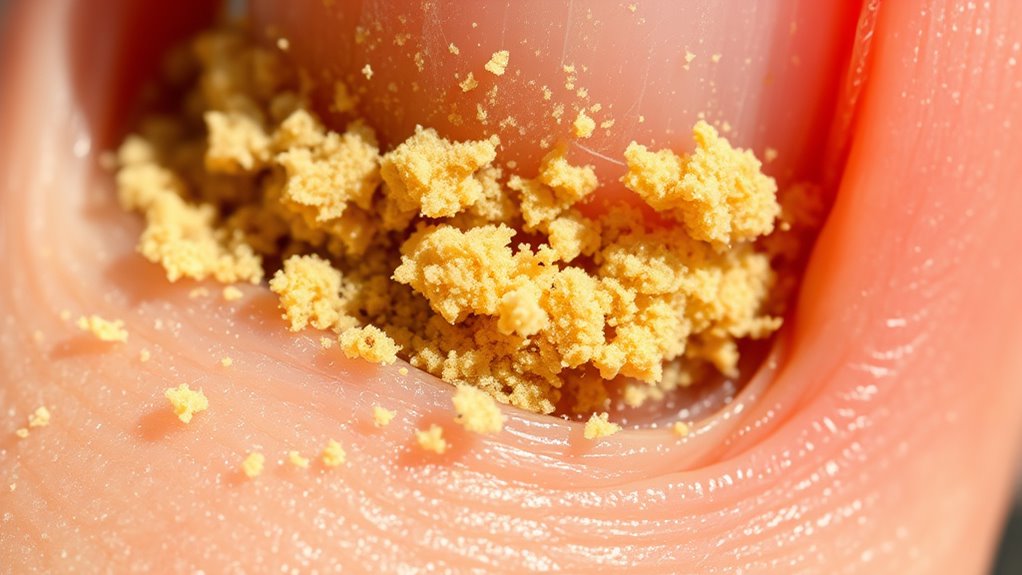
Excessive nail debris beneath the nail is a common warning sign of nail fungus. When you notice debris accumulation under nails, it often indicates a fungal infection taking hold. This buildup of nail debris can cause your nails to look discolored and thickened. You might also observe a foul smell or rough texture emerging around the affected area. Prompt attention to debris buildup can prevent the infection from worsening. Keep an eye out for these signs:
Excessive nail debris signals possible fungal infection and requires prompt attention.
- Noticeable accumulation of debris under nails
- Discoloration or yellowing of the nail
- Thickening or distortion of the nail shape
- Foul odor emanating from the nail
- Crumbling or brittle nail edges
Addressing nail debris buildup early helps in managing the infection effectively and avoiding further complications. Incorporating mindfulness practices can also help reduce stress, which may support immune function and aid in recovery.
Pain or Discomfort in the Affected Area

When nail fungus advances, you may start feeling pain or discomfort around the affected area. This nail pain can range from a dull ache to sharper sensations, especially when pressing on the nail or walking. Nail discomfort often signals that the infection is worsening and affecting the surrounding tissues. You might notice a throbbing sensation or soreness that persists even at rest. As the fungus spreads, the nail may become more sensitive to touch, making daily activities uncomfortable. Ignoring this warning can lead to increased pain and potential spread of the infection. Early action, such as seeking treatment, is vital to prevent further damage. Pay close attention to any new or worsening pain to catch the problem before it escalates. Recognizing symptoms can help you identify the need for prompt care and support recovery.
Visible Skin Changes or Infections Near the Nails
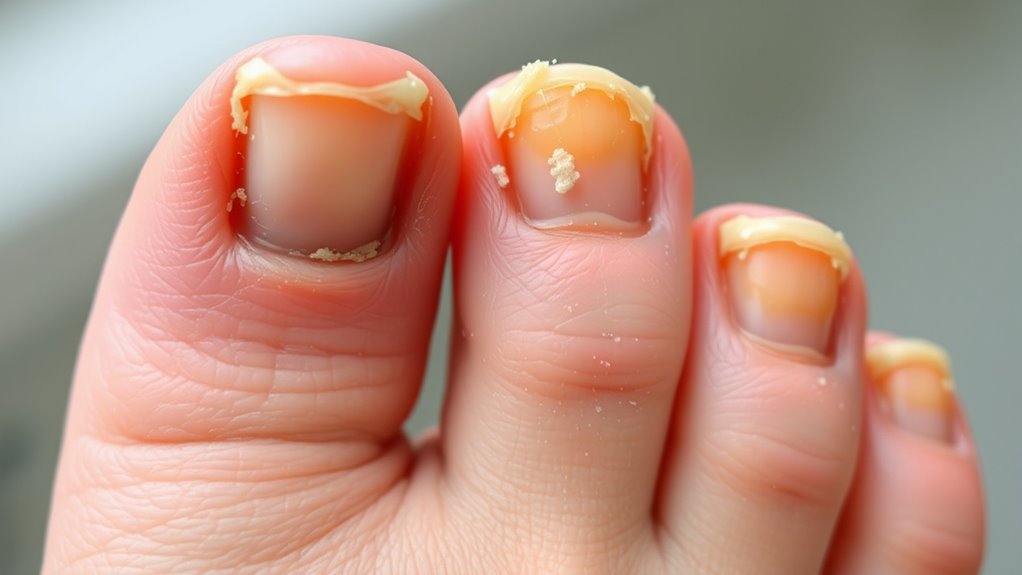
Visible skin changes or infections near the nails often serve as clear signs that a fungal infection is spreading beyond the nail itself. You might notice signs of skin infection such as redness, swelling, or warmth around the affected area. Skin irritation symptoms can include itching, burning sensations, or tenderness. These changes indicate the infection is progressing and may require prompt attention. Ignoring these signs can lead to more serious complications, including cellulitis or bacterial superinfection. It’s vital to monitor these skin alterations carefully. Early intervention can prevent the infection from worsening. Recognizing the following indicators can help you act swiftly:
- Redness and swelling around the nail
- Discolored or inflamed skin
- Pain or tenderness near the affected area
- Skin peeling or cracking
- Pus or fluid drainage
Frequently Asked Questions
Can Nail Fungus Be Transmitted Through Contact With Contaminated Surfaces?
Yes, nail fungus can be transmitted through contact with contaminated surfaces. When you walk barefoot in public showers, gyms, or pool areas, you risk picking up the fungus from contaminated surfaces. The transmission risk increases if your skin is broken or if your nails are damaged. To reduce the risk, always wear protective footwear and avoid sharing personal items, as fungi thrive on damp, contaminated surfaces.
Are There Natural Remedies Effective in Early Nail Fungus Treatment?
You might wonder if natural remedies work early on for nail fungus. Herbal extracts like tea tree oil, oregano oil, and apple cider vinegar are popular home remedies that can help inhibit fungal growth. While some studies suggest they may be effective, results vary. It’s best to try these options early and consistently, but if the infection persists, consult a healthcare professional for proper treatment.
How Long Does It Typically Take to See Improvement After Treatment?
You can usually see improvement within 4 to 6 weeks after starting treatment, but the full treatment duration varies depending on the severity. Your improvement timeline depends on factors like the type of treatment and how well you follow it. Consistent application and patience are key. Keep in mind, it might take several months for the nail to fully recover and for the fungus to disappear completely.
Can Nail Fungus Cause Permanent Damage if Left Untreated?
If you ignore nail fungus, it can cause permanent damage, like a broken record that keeps playing. Left untreated, it compromises your nail health, leading to thickening, crumbling, and deformity. Fungal consequences can extend beyond the nail, affecting surrounding skin and even causing pain. Don’t wait until it’s too late—early treatment is your best bet to prevent lasting damage and restore healthy nails.
Are Certain Groups More Prone to Developing Nail Fungus?
Yes, some groups are more prone to developing nail fungus. You might be at higher risk if you have a genetic predisposition, which can make you more susceptible. Age-related susceptibility also plays a role; older adults tend to experience more frequent infections due to weaker immune systems and slower nail growth. Additionally, factors like compromised circulation and certain health conditions increase your chances of fungal infections.
Conclusion
If you notice your nails turning yellow, thickening, or crumbling like fragile leaves, don’t ignore the warning signs. Picture your nails as tiny shields, now cracked and worn, signaling an infection inside. Taking quick action can stop the fungal invasion from spreading further, saving your nails and confidence. Remember, early treatment is your best defense—so listen to your body, act swiftly, and keep your nails healthy and strong.
